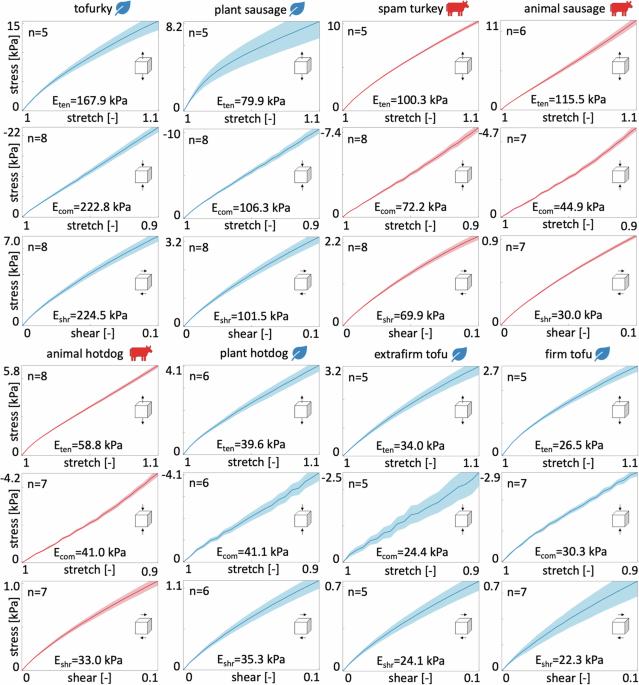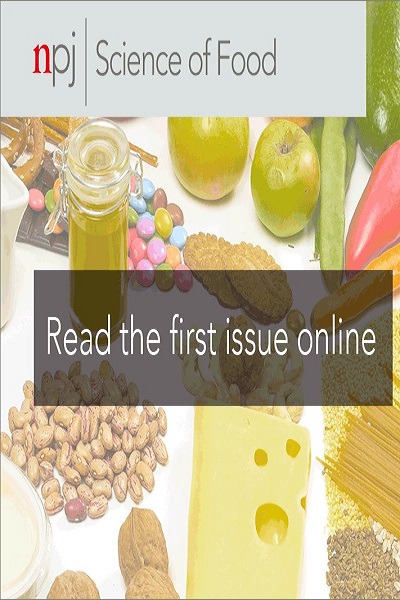The mechanical and sensory signature of plant-based and animal meat
IF 6.3
1区 农林科学
Q1 FOOD SCIENCE & TECHNOLOGY
引用次数: 0
Abstract
Eating less meat is associated with a healthier body and planet. Yet, we remain reluctant to switch to a plant-based diet, largely due to the sensory experience of plant-based meat. Food scientists characterize meat using a double compression test, which only probes one-dimensional behavior. Here we use tension, compression, and shear tests–combined with constitutive neural networks–to automatically discover the behavior of eight plant-based and animal meats across the entire three-dimensional spectrum. We find that plant-based sausage and hotdog, with stiffnesses of 95.9 ± 14.1 kPa and 38.7 ± 3.0 kPa, successfully mimic their animal counterparts, with 63.5 ± 45.7 kPa and 44.3 ± 13.2 kPa, while tofurky is twice as stiff, and tofu is twice as soft. Strikingly, a complementary food tasting survey produces in nearly identical stiffness rankings for all eight products (ρ = 0.833, p = 0.015). Probing the fully three-dimensional signature of meats is critical to understand subtle differences in texture that may result in a different perception of taste. Our data and code are freely available at https://github.com/LivingMatterLab/CANN

植物肉和动物肉的机械和感官特征。
少吃肉与更健康的身体和地球息息相关。然而,我们仍然不愿意改吃植物性饮食,主要原因是植物性肉类的感官体验。食品科学家使用双重压缩试验来描述肉类的特性,这种试验只能探测肉类的一维行为。在这里,我们使用拉伸、压缩和剪切测试,结合构成神经网络,自动发现八种植物肉和动物肉在整个三维范围内的行为。我们发现,植物香肠和热狗的硬度分别为 95.9 ± 14.1 kPa 和 38.7 ± 3.0 kPa,它们成功地模仿了动物肉类的硬度,分别为 63.5 ± 45.7 kPa 和 44.3 ± 13.2 kPa,而香肠的硬度是动物肉类的两倍,豆腐的硬度是动物肉类的两倍。令人吃惊的是,对所有八种产品进行的互补性食品品尝调查得出的硬度排名几乎完全相同(ρ = 0.833,p = 0.015)。探究肉类的全三维特征对于了解质地的细微差别至关重要,而质地的细微差别可能会导致不同的味觉感受。我们的数据和代码可在 https://github.com/LivingMatterLab/CANN 免费获取。
本文章由计算机程序翻译,如有差异,请以英文原文为准。
求助全文
约1分钟内获得全文
求助全文
来源期刊

NPJ Science of Food
FOOD SCIENCE & TECHNOLOGY-
CiteScore
7.50
自引率
1.60%
发文量
53
期刊介绍:
npj Science of Food is an online-only and open access journal publishes high-quality, high-impact papers related to food safety, security, integrated production, processing and packaging, the changes and interactions of food components, and the influence on health and wellness properties of food. The journal will support fundamental studies that advance the science of food beyond the classic focus on processing, thereby addressing basic inquiries around food from the public and industry. It will also support research that might result in innovation of technologies and products that are public-friendly while promoting the United Nations sustainable development goals.
 求助内容:
求助内容: 应助结果提醒方式:
应助结果提醒方式:


